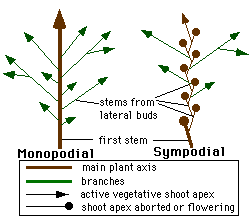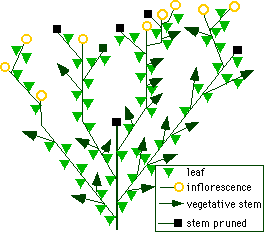 I. GENERAL GROWTH HABIT:
I. GENERAL GROWTH HABIT: Tomato varieties vary in growth habit from vines which spread horizontally (decumbent), to bush-like (erect). II. PHYLLOTAXY: The arrangement of leaves on a stem is called phyllotaxy. Tomato phyllotaxy is termed spiral because only one leaf is present at each node and each successive leaf is displaced approximately 137.5 degrees from the last. Thus a line connecting successively older leaves (leaves #1 to #5 in the figure) would make a spiral. III. BRANCHING:
1. Terminal and Lateral buds. While the terminal bud (or shoot apex) of the stem is growing vegetatively (producing leaves), the growth of lateral branches is somewhat inhibited ("apical dominance"). Eventually, however, the terminal bud stops growing because it has aborted, been cut off by pruning, or it forms an inflorescence (branches producing flowers rather than leaves). When this happens, the lateral branches grow out. 2. Sympodial and Monopodial Stems 
a. In many plant species, the first stem grows vegetatively for many years, forming the main axis of the plant by itself. This kind of axis is called monopodial. b. In other plants, such as the tomato, the first stem terminates rather early. A lateral branch will take over and grow out for several nodes. Soon this branch terminates (often after a strict number of nodes bearing leaves) and a lateral branch takes over, and so on. In this kind of plant, the main axis is composed of many lateral branches, and is called sympodial. | |
3. Branching in Tomato:branching diagrams made from pruned and unpruned greenhouse-grown plants. | |

|
 |
| a. In the tomato, the main axis of the young plant is monopodial. However, once the shoot apex is induced to flower and forms an inflorescence, further growth is sympodial. This later growth is characterized by 3-4 nodes of vegetative growth before a terminal inflorescence is formed. | b. This branching diagram, drawn from observations of a pruned tomato plant, shows how pruning dramatically affects the shape of the shoot system. By pruning the main axis early, several lateral buds were released from apical dominance and allowed to grow out. This plant therefore has several main axes. Ultimately these axes began to flower and further growth was sympodial. |